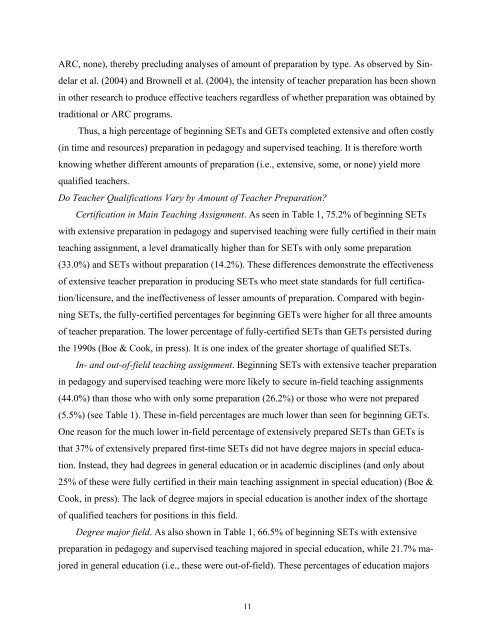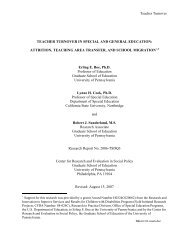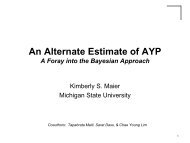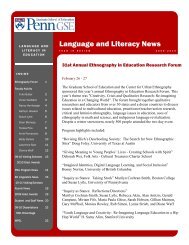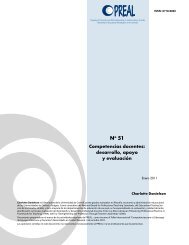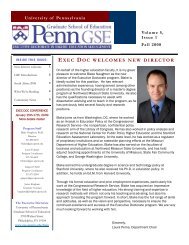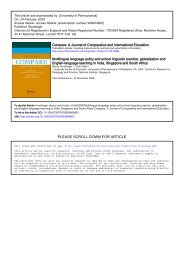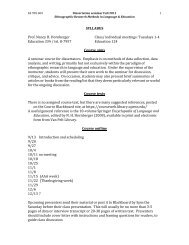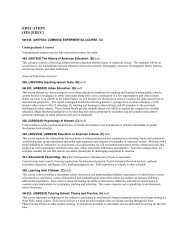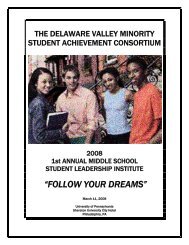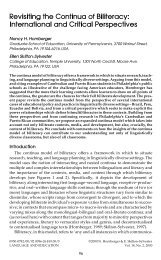does teacher preparation matter for beginning teachers in
does teacher preparation matter for beginning teachers in
does teacher preparation matter for beginning teachers in
You also want an ePaper? Increase the reach of your titles
YUMPU automatically turns print PDFs into web optimized ePapers that Google loves.
ARC, none), thereby preclud<strong>in</strong>g analyses of amount of <strong>preparation</strong> by type. As observed by S<strong>in</strong>delar<br />
et al. (2004) and Brownell et al. (2004), the <strong>in</strong>tensity of <strong>teacher</strong> <strong>preparation</strong> has been shown<br />
<strong>in</strong> other research to produce effective <strong>teacher</strong>s regardless of whether <strong>preparation</strong> was obta<strong>in</strong>ed by<br />
traditional or ARC programs.<br />
Thus, a high percentage of <strong>beg<strong>in</strong>n<strong>in</strong>g</strong> SETs and GETs completed extensive and often costly<br />
(<strong>in</strong> time and resources) <strong>preparation</strong> <strong>in</strong> pedagogy and supervised teach<strong>in</strong>g. It is there<strong>for</strong>e worth<br />
know<strong>in</strong>g whether different amounts of <strong>preparation</strong> (i.e., extensive, some, or none) yield more<br />
qualified <strong>teacher</strong>s.<br />
Do Teacher Qualifications Vary by Amount of Teacher Preparation?<br />
Certification <strong>in</strong> Ma<strong>in</strong> Teach<strong>in</strong>g Assignment. As seen <strong>in</strong> Table 1, 75.2% of <strong>beg<strong>in</strong>n<strong>in</strong>g</strong> SETs<br />
with extensive <strong>preparation</strong> <strong>in</strong> pedagogy and supervised teach<strong>in</strong>g were fully certified <strong>in</strong> their ma<strong>in</strong><br />
teach<strong>in</strong>g assignment, a level dramatically higher than <strong>for</strong> SETs with only some <strong>preparation</strong><br />
(33.0%) and SETs without <strong>preparation</strong> (14.2%). These differences demonstrate the effectiveness<br />
of extensive <strong>teacher</strong> <strong>preparation</strong> <strong>in</strong> produc<strong>in</strong>g SETs who meet state standards <strong>for</strong> full certification/licensure,<br />
and the <strong>in</strong>effectiveness of lesser amounts of <strong>preparation</strong>. Compared with <strong>beg<strong>in</strong>n<strong>in</strong>g</strong><br />
SETs, the fully-certified percentages <strong>for</strong> <strong>beg<strong>in</strong>n<strong>in</strong>g</strong> GETs were higher <strong>for</strong> all three amounts<br />
of <strong>teacher</strong> <strong>preparation</strong>. The lower percentage of fully-certified SETs than GETs persisted dur<strong>in</strong>g<br />
the 1990s (Boe & Cook, <strong>in</strong> press). It is one <strong>in</strong>dex of the greater shortage of qualified SETs.<br />
In- and out-of-field teach<strong>in</strong>g assignment. Beg<strong>in</strong>n<strong>in</strong>g SETs with extensive <strong>teacher</strong> <strong>preparation</strong><br />
<strong>in</strong> pedagogy and supervised teach<strong>in</strong>g were more likely to secure <strong>in</strong>-field teach<strong>in</strong>g assignments<br />
(44.0%) than those who with only some <strong>preparation</strong> (26.2%) or those who were not prepared<br />
(5.5%) (see Table 1). These <strong>in</strong>-field percentages are much lower than seen <strong>for</strong> <strong>beg<strong>in</strong>n<strong>in</strong>g</strong> GETs.<br />
One reason <strong>for</strong> the much lower <strong>in</strong>-field percentage of extensively prepared SETs than GETs is<br />
that 37% of extensively prepared first-time SETs did not have degree majors <strong>in</strong> special education.<br />
Instead, they had degrees <strong>in</strong> general education or <strong>in</strong> academic discipl<strong>in</strong>es (and only about<br />
25% of these were fully certified <strong>in</strong> their ma<strong>in</strong> teach<strong>in</strong>g assignment <strong>in</strong> special education) (Boe &<br />
Cook, <strong>in</strong> press). The lack of degree majors <strong>in</strong> special education is another <strong>in</strong>dex of the shortage<br />
of qualified <strong>teacher</strong>s <strong>for</strong> positions <strong>in</strong> this field.<br />
Degree major field. As also shown <strong>in</strong> Table 1, 66.5% of <strong>beg<strong>in</strong>n<strong>in</strong>g</strong> SETs with extensive<br />
<strong>preparation</strong> <strong>in</strong> pedagogy and supervised teach<strong>in</strong>g majored <strong>in</strong> special education, while 21.7% majored<br />
<strong>in</strong> general education (i.e., these were out-of-field). These percentages of education majors<br />
11


